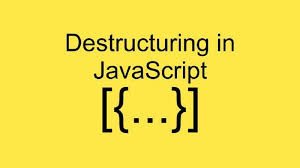Introduction
Destructuring in JavaScript is a powerful feature introduced in ECMAScript 2015 (ES6) that provides a concise way to extract values from arrays, objects, and other data structures. It allows developers to unpack values from arrays or properties from objects into distinct variables, making code more readable and expressive.

Features of Destructuring in JavaScript
1. Array Destructuring
Destructuring allows you to extract values from arrays and assign them to variables in a single statement, simplifying code and improving clarity.
2. Object Destructuring
It can also extract values from objects by using their property names as variable names, enabling easier access to object properties.
3. Nested Destructuring
Destructuring supports nested arrays and objects, allowing you to extract values from deeply nested structures in a concise and intuitive way.
4. Default Values
Destructuring syntax supports default values, which are used when the extracted value is undefined.
Examples of Destructuring in JavaScript
1. Array Destructuring
const numbers = [1, 2, 3];
const [a, b, c] = numbers;
console.log(a, b, c); // Output: 1 2 32. Object Destructuring
const person = { name: 'Alice', age: 30 };
const { name, age } = person;
console.log(name, age); // Output: Alice 303. Nested Destructuring
const data = { user: { name: 'Bob', age: 25 } };
const { user: { name, age } } = data;
console.log(name, age); // Output: Bob 254. Default Values
const numbers = [1];
const [a, b = 0] = numbers;
console.log(a, b); // Output: 1 0Why Should We Use Destructuring in JavaScript
1. Code Readability
Destructuring improves code readability by providing a concise and expressive syntax for extracting values from arrays and objects.
2. Simplification of Code
By unpacking values from data structures into distinct variables, destructuring simplifies code and reduces the need for repetitive assignments.
3. Avoiding Repetitive Access
Destructuring allows you to extract values from arrays and objects directly into variables, avoiding repetitive access to nested properties or array elements.
4. Easier Parameter Passing
Destructuring simplifies parameter passing by enabling the extraction of values from objects directly in function arguments.
Advantages of Destructuring in JavaScript
1. Simplicity
Destructuring simplifies code by providing a concise syntax for extracting values from arrays, objects, and other data structures.
2. Flexibility
Destructuring supports default values, nested structures, and renaming variables, providing flexibility in extracting values from complex data structures.
3. Improved Code Maintainability
By making code more readable and expressive, destructuring enhances code maintainability, making it easier to understand and modify.
4. Enhanced Productivity
Destructuring reduces the need for repetitive code patterns, leading to faster development and increased productivity.
Conclusion
Destructuring is a powerful feature in JavaScript that simplifies code by providing a concise syntax for extracting values from arrays, objects, and other data structures. By improving code readability, simplifying parameter passing, and enhancing code maintainability, destructuring contributes to more expressive and efficient JavaScript programming.
Frequently Asked Questions
Yes, destructuring can be used with functions that return arrays or objects to unpack the returned values into distinct variables.
Yes, destructuring can be combined with other features like default parameters and spread syntax to create more powerful and expressive code patterns.
Destructuring is supported in most modern JavaScript environments, including browsers and Node.js. For older environments, a transpiler like Babel may be required.

